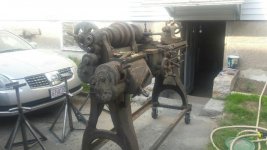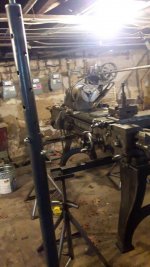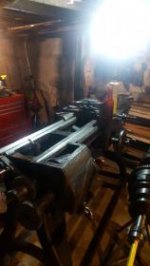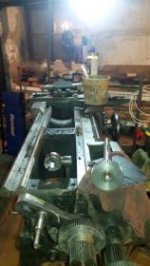David:
Welcome to our forum. Seeing a young person such as yourself taking an active interest in old machine tools, as well as wanting to learn machine work is always a refreshing thing to many of us. Unfortunately, parts for old machine tools are almost non existant. Part of the process of owning and working with old machine tools is making parts and tooling for them.
It has been said that the screw-cutting lathe is 'the mother of all machine tools' in that it can make its own parts as well as parts for other machine tools. Such is the case with your need for a chuck backplate. There was no industry standard on spindle nose threads used on lathes. Each manufacturer followed their own ideas as to the design of the lathes in general and the spindle nose and its threads in particular. The type of chuck used on this sort of lathe is known as a 'plain back chuck'.
The plain back chuck will need to be mounted on a back plate. The backplate is bored and threaded to fit onto the spindle of the lathe. Years ago, some of the lathe manufacturers sold 'semi machined' backplates, having been bored and threaded to fit their lathes' spindles. It was up to the customer to buy the chuck and machine the backplate to fit the chuck. The backplate was machined by screwing it onto the spindle of the lathe, with the result being a backplate that was dead square and dead true to the spindle.
The plain back chuck will have mounting screws that run from the front face of the chuck body through it, projecting out the back of the chuck body. The back of the chuck body will usually be faced and counterbored with a shallow recess. The purpose of this counterbore or recess is to provide a 'register' for locating the chuck on the backplate. The user of the lathe would mike the counterbore in the back of the chuck, and with the backplate screwed onto the spindle of the lathe, machine a mating 'spigot' on the backplate for a close fit in the counterbore in the chuck. The mounting screws are run into holes which are tapped thru the backplate .
It was quite common for machine shop supply firms to have a stock of rough iron castings for chuck backplates. Nowadays, those sorts of backplate castings are not so common and usually quite pricey. An alternative is to make a backplate from steel plate and heavy round stock for the 'hub' or center boss. Cutting a disc out of steel plate at least 1/2" thick, and setting it up on your lathe in the 3 jaw chuck (assuming you have reversible jaws), the disc has a center hole bored thru it. A center hub or boss is then machined on your lathe from heavy round stock (maybe 3" diameter or a little larger). A step or shoulder is machined on the round stock so that it seats snugly in the bored hole in the disc and squares the boss to the disc. Machine a heavy chamfer on the 'front' end of the boss and at the mouth of the bore in the disc. This will let you get plenty of weld with nearly complete penetration to tie the boss to the disc.
When you have the boss/disc welded solidly together, chuck the hub in your 3 jaw chuck and put a center in the boss. This will support the backplate while you rought turn the outer diameter and take a facing cut across it. Once you have the disc rough machined, hold it in the 3 jaw chuck with jaws reversed so you can bore thru the hub. In a pinch, you can dismount the 3 jaw chuck from the backplate and use the chuck mounting screws to pull the partially machined backplate against it. If your 3 jaw chuck does not open up large enough, or you do not have reverse jaws for it, or no faceplate, this is a way to machine the new backplate in your lathe.
As a first step in making backplates to fit your lathe spindle, I make what I call a 'dummy spindle' or gauge. This is a piece of round stock which is machined and threaded to the same dimensions as the lathe spindle. I highly recommend measuring the spindle threads on your lathe using the '3 wire method'. This will give you a very precise measurement on the depth of threads on the spindle. Machine this dummy or gauge as close to actual 'as measured' dimensions of the lathe spindle as you can. The dummy spindle can be machined from anything handy: cold rolled steel, hot rolled steel, aluminum, or heavy-wall steel mechanical tube.
Make sure that your dummy spindle screws smoothly yet snugly into the chuck backplate.
Once you have the dummy spindle, you can then start on the boring and threading of the hub on your welded steel backplate. Using the 3 wire method, you will be able to get the correct diameter to bore the hub to for cutting the internal thread. My own recommendation is to make at least two of these backplates. One can be used for a 4 jaw chuck, and one- with the addition of a larger plate disc- can become a faceplate.
Similarly, if you need a steady rest, the most expedient thing is to make one. Some people cut steady rests from heavy steel plate and machine the parts as required.
I do not know what other machine tools you have at your disposal, but making a steady rest will require a milling machine or shaper to machined the correct profile to the base so it mates onto the bedways.
In the 'for what it's worth' department: the four jaw 'independent' (each jaw independently adjustable) is the most versatile of all the lathe chucks. If I were stuck aboard ship out at sea, or in some remote place and could only have one chuck for the lathe, it would be the 4 jaw independent chuck. You can chuck odd shaped jobs in a 4 jaw chuck, and you can indicate a job so it is running dead true with the centerline of the spindle. You also get more holding power from a 4 jaw chuck with each jaw having its own clamping screw. I tend to keep the 4 jaw chucks on my lathes most of the time. As a kid at Brooklyn Technical HS in the 60's, by our junior year, we were running Hendey geared head engine lathes. Our teacher , a master toolmaker, told us to avoid using the 3 jaw chucks, and we used the 4 jaw chucks almost exclusively. We had to be able to 'setup a job' in a 4 jaw chuck and get it running with about 0.015" ( 1/64th inch) of true by eye before we were allowed to use a dial indicator.
Learning to cut threads including the shop math, measuring 'over the wires', and grinding the toolbits is what separates people who claim to be able to 'run a lathe' from the people who really can. As an old German immigrant machine shop foreman told me when I was a teenager: "Anyone can chuck a piece of round stock in a 3 jaw chuck and take a cut on it... being able to setup a real job on a faceplate is a different story." A screw cutting lathe is an amazing machine tool in the right hands. Learn to use your lathe to something approaching its full capabilities and make what you need for it.




















